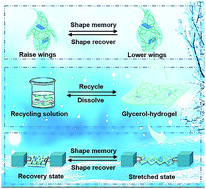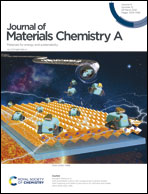A transparent glycerol-hydrogel with stimuli-responsive actuation induced unexpectedly at subzero temperatures†
Abstract
Smart hydrogels with the capability of programmable shape memory have the potential to revolutionize medicine and soft robotics. Despite significant progress in designing hydrogels with ever more sophisticated shape memory behaviors, an ultimate goal yet to be fulfilled is programmable shape memory at subzero temperatures. Herein, an effective route has been demonstrated to address this challenge by constructing a transparent poly(vinyl alcohol)/carboxymethyl cellulose/functionalized boron nitride nanosheet glycerol-hydrogel. The resultant glycerol-hydrogel exhibited outstanding transparency (76% at 600 nm), dehydration resistance to high temperatures (60 °C) and anti-freezing performance at low temperatures (−70 °C). Furthermore, excellent programmable shape memory was demonstrated by shape memory and recovery cycles at −45 °C. Based on the shape memory capability of the glycerol-hydrogel, a through-line patterned actuator designed from the hierarchical kirigami structure could effectively carry cargoes for movement and control circuit switches by external stimuli at subzero temperatures. These outstanding programmable shape memory capabilities are expected to greatly extend the technical scope of hydrogel-based devices.



 Please wait while we load your content...
Please wait while we load your content...